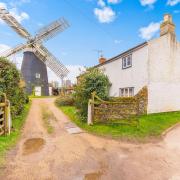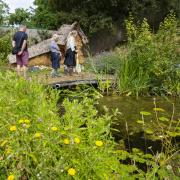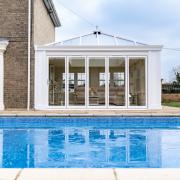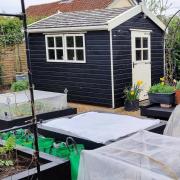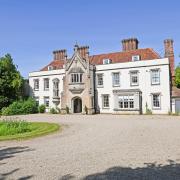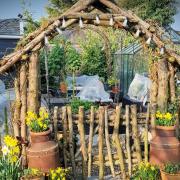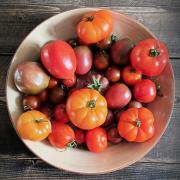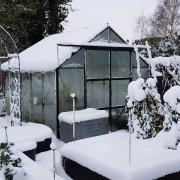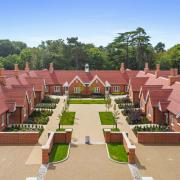What might we expect from a four-times Chelsea gold medallist when it comes to his own Suffolk garden? Marion Welham finds out.
A relentless summer drought followed by a brutally cold winter was a stark reminder of how we may need to break with some of our garden conventions. Award-winning garden designer Tom Hoblyn is way ahead on planting solutions for our changing climate, taking time to experiment in his 2.5-acre garden in Bardwell. His latest test bed is the gravel garden by the house, built to 'cheat winter'. Here the French lavender has been knocked back by the cold, no surprise there, but the more unusual Sarcopoterium (spiny burnet) and Euphorbia ‘Grey Hedgehog’ seem to have made it through and there’s a handsome Pistacia shrub in a sheltered corner.

'They shouldn’t be hardy but they seem okay because of the way I’ve constructed the gravel garden so their feet never sit in water.' He’s used an amber-coloured stone from a local quarry to achieve this. 'I think what really kills plants is when they get waterlogged, but if they stay dry sometimes they’ll get through.' And Tom really does know about wet and dry conditions. His garden slopes west towards the Black Bourne river, with far-reaching views across the wetland and beyond to include a further 10 acres that he manages on behalf of others.
'Normally it’s very wet in the winter from flooding, which is beautiful but then in the summer it’s bone dry. We get 516 mm of rain a year here and we’ve obviously got some of the highest sunshine levels in England, so it’s good to experiment with different groups of plants to see how they perform.' As we wander towards the magnificent, multi-stemmed alder in the distance, I’m wondering if the rich river soil might be a boon for growing a wide variety of plants.
'Well you would think that,' says Tom. 'It’s silty loam, but our pH is very alkaline and we also have a manganese deficiency which manifests itself in certain plants. Anything with quite a thin leaf, such as Amelanchier and Japanese maples, get blotches in June or July and look awful by the end of the year.' Such careful observations have enabled him to record what does well and what struggles, no doubt invaluable when it comes to selecting plants for his clients. One surprise in his own garden was the fact that bearded irises, and Iris siberica in particular, do so well, a favourite being the deep, velvety violet ‘Caesar’s Brother’, the foliage left to provide winter mulch. Paeonies were another revelation.

'They really do well in our soil but technically I thought they wouldn’t. I’d have put money on it.' As a result, he has planted them with Cedric Morris iris cultivars, such as the rosy, plum-toned ‘Benton Deirdre’ and the ruffled creamy-white, violet-edged ‘Benton Lorna’ in artfully curved borders where the planting is more formal near the house. Spreading branches of Prunus ‘Shirotae’ provide an avenue of fragrant white blossom in spring.
Looking across to pleached hornbeams sheltering a simple rectangular swimming pool, there’s a wild flower meadow beyond, managed for whatever wild plants might appear, in Tom’s case three species of wild orchid. He’s keen to distinguish between deliberately-sown cornfield annuals and whatever will grow naturally if left alone. Another area is dedicated to six of Tom’s favourite grasses, among them the lovely fountain grasses including Pennisetum ‘Fairy Tails’, Miscanthus ‘Starlight’ with its silvery-green leaves turning gold in autumn, and the purple moor grass Molinea ‘Transparent’.
Tom didn’t deliberately plan the lay-out in his own garden, although he concedes good-humouredly that his wife Mary cuts the grass nearer to the house as 'she likes a well-kept lawn'. But both he and Mary appreciate the beauty of the wild wetland, and neighbours, too, are keen on wildlife corridors, the ends of their gardens linking up so wildlife can move freely. Tom came to rewilding early on when he was studying at Royal Botanic Gardens Kew in 1999. ‘Before it was a word,’ he laughs. 'At Kew I got really interested in natural landscapes, which I use in my design practice now, and we deliberately let our bottom acreage go wild. We let all the brambles grow back and now we’ve got oak trees coming through them which is exactly what should happen.'

The wet woodland is the place for crack willow, the aptly named Salix fragilis, which splits with cracks and fissures, its tangled roots providing a habitat for wildlife. There’s also a stumpery where tree stumps and bark bring more wildness into the garden as well as colour from vivid green shuttlecock fern, the soft shield fern Polystichum setiferum and the native wood melick with tiny white flowers against green foliage. Surplus wood is chipped for mulch so nothing is wasted.
The larger trees support rambling roses such the pink Blush Rambler, vigorous ‘Wedding Day’ and creamy white Bobbie James, filling the air with their fragrance in late spring and early summer. There are ponds and streams and a bridge built by Tom makes a lovely focal point being his 'interpretation of a Monet bridge' His current project is a little summer house for views across the wetland for which he’s using stone from Snetterton quarry and a blow torch to burn the wood black instead of painting it.

A favourite task is growing vegetables in large walled garden with a crinkle-crankle far wall “that almost sold the house to us” and a handsome greenhouse dubbed Tom’s “lab.” Fruit trained in espaliers include the apples ‘Newton Wonder’ and ‘Laxton’s Superb’ and the pear ‘Beurre Hardy’. It ties in neatly with a family theme as Tom’s grandfather got an OBE for his work on dwarf fruiting rootstocks while his eldest son Harry has a tree nursery raising 250,000 seedling trees for woodland creation schemes.
Tom studied agriculture before going to Kew in order to take over the family farm in Cornwall but, in the end, chose not to take that route.'Agriculture was a good start because understanding the land is very important, for climate and soil obviously and useful because so many of my design projects are in rural settings such as farmhouses or old rectories.' To that portfolio he might add smart London properties and, more recently, a series of Norfolk Broads gardens that often extend into the water.

He's currently working on a commission from Peterhouse, oldest of the Cambridge colleges, to create gardens on three acres to benefit the health and wellbeing of the students and to reflect the history of the college. It’s a significant moment in his long design career, not least as the college wanted him to set a new benchmark for college gardens in university cities in terms of nature and climate change.
'Whereas we tend to associate most college gardens with perfect stripy lawns, this scheme is, I guess, a more manicured version of my garden.' A highlight will be a water feature using rainwater off the roofs of the halls, inspired by the late 16th century Hobson’s Conduit bringing fresh water into the city from Nine Wells springs at the base of Gog Magog hills.
Tom is a regular at RHS Chelsea and winner of four gold medals. More noteworthy for him, however, was the People’s Choice Award in 2012 for his Arthritis Research UK garden. 'To me that was almost more valuable than the medal – to get acknowledged by the public.'
thomashoblyn.com
READ MORE: What’s in store at this year’s RHS Chelsea Flower Show?

Chelsea garden highlight British crafts
After winning a gold medal for his Boodles Travel Garden for RHS Chelsea last year and a Silver Gilt for the Boodles Secret Garden the year before, Tom Hoblyn has again been commissioned by the luxury jewellery company for this year’s show.
His ‘Best of British’ Sanctuary garden is about celebrating the best of British craftsmanship.
“Boodles design and make all their jewellery in this country and they have highly-skilled craft people so they wanted me to carry that on into the garden,” says Tom.
His inspiration came from pre-Raphaelite paintings with refined and stylised forms of plants and colours amplified.
“This year I’m using some quite strong pinks and some purply burgundy colours and quite a lot of acidy yellow.”
The garden features an arbour with metal roof tiles to depict leaves and a branch-like pillar going through to represent woodland. Tom has used selected forms of native trees such as a weeping birch and the cut-leaved alder, Alnus glutinosa ‘Imperialis’ with the rambling rose ‘Félicité Perpétue’ over the arbour.
An exciting water feature with a 3x2 metre pool above ground “will look like it’s floating and that it’s raining,” Tom explains. It involves some clever engineering with 150 jets creating the effect of rain. “But it won’t be raining or at least I just hope it doesn’t rain at Chelsea this year!”





